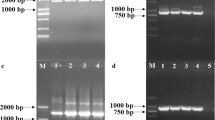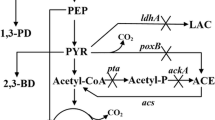Abstract
1,3-Propanediol (1,3-PD) can be used for the industrial synthesis of a variety of compounds, including polyesters, polyethers, and polyurethanes. 1,3-PD is generated from petrochemical and microbial sources. 1,3-Propanediol is a typical product of glycerol fermentation, while acetate, lactate, 2,3-butanediol, and ethanol also accumulate during the process. Substrate and product inhibition limit the final concentration of 1,3-propanediol in the fermentation broth. It is impossible to increase the yield of 1,3-propanediol by using the traditional whole-cell fermentation process. In this study, dhaD and dhaK, the genes for glycerol dehydrogenase and dihydroxyacetone kinase, respectively, were inactivated by homologous recombination in Klebsiella pneumoniae. The dhaD/dhaK double mutant (designated TC100), selected from 5,000 single or double cross homologous recombination mutants, was confirmed as a double cross by using polymerase chain reaction. Analysis of the cell-free supernatant with high-performance liquid chromatography revealed elimination of lactate and 2,3-butanediol, as well as ethanol accumulation in TC100, compared with the wild-type strain. Furthermore, 1,3-propanediol productivity was increased in the TC100 strain expressing glycerol dehydratase and 1,3-PDO dehydrogenase regulated by the arabinose PBAD promoter. The genetic engineering and medium formulation approaches used here should aid in the separation of 1,3-propanediol from lactate, 2,3-butanediol, and ethanol and lead to increased production of 1,3-propanediol in Klebsiella pneumoniae.




Similar content being viewed by others
References
Abbad-Andaloussi S, Manginot-Durr C, Amine J, Petitdemange E, Petitdemange H (1995) Isolation and characterization of clostridium butyricum DSM 5431 mutants with increased resistance to 1,3-propanediol and altered production of acids. Appl Environ Microbiol 61:4413–4417
Ahrens K, Menzel K, Zeng A, Deckwer W (1998) Kinetic, dynamic, and pathway studies of glycerol metabolism by Klebsiella pneumoniae in anaerobic continuous culture: III. Enzymes and fluxes of glycerol dissimilation and 1,3-propanediol formation. Biotechnol Bioeng 59:544–552
Barbirato F, Grivet JP, Soucaille P, Bories A (1996) 3-Hydroxypropionaldehyde, an inhibitory metabolite of glycerol fermentation to 1,3-propanediol by enterobacterial species. Appl Environ Microbiol 62:1448–1451
Biebl H, Menzel K, Zeng AP, Deckwer WD (1999) Microbial production of 1,3-propanediol. Appl Microbiol Biotechnol 52:289–297
Biebl H, Zeng AP, Menzel K, Deckwer WD (1998) Fermentation of glycerol to 1,3-propanediol and 2,3-butanediol by Klebsiella pneumoniae. Appl Microbiol Biotechnol 50:24–29
Chen HW, Fang BS, Hu ZD (2005) Optimization of process parameters for key enzymes accumulation of 1,3-propanediol production from Klebsiella pneumoniae. Biochem Eng J 25:47–53
Daniel R, Stuertz K, Gottschalk G (1995) Biochemical and molecular characterization of the oxidative branch of glycerol utilization by Citrobacter freundii. J Bacteriol 177:4392–4401
de Lorenzo V, Herrero M, Jakubzik U, Timmis KN (1990) Mini-Tn5 transposon derivatives for insertion mutagenesis, promoter probing, and chromosomal insertion of cloned DNA in gram-negative eubacteria. J Bacteriol 172:6568–6572
Fenghuan W, Huijin Q, He H, Tan T (2005) High-level expression of the 1,3-propanediol oxidoreductase from Klebsiella pneumoniae in Escherichia coli. Mol Biotechnol 31:211–219
Forage RG, Foster MA (1982) Glycerol fermentation in Klebsiella pneumoniae: functions of the coenzyme B12-dependent glycerol and diol dehydratases. J Bacteriol 149:413–419
Forage RG, Lin EC (1982) DHA system mediating aerobic and anaerobic dissimilation of glycerol in Klebsiella pneumoniae NCIB 418. J Bacteriol 151:591–599
Forsberg CW (1987) Production of 1,3-propanediol from glycerol by clostridium acetobutylicum and other clostridium species. Appl Environ Microbiol 53:639–643
Johnson EA, Lin EC (1987) Klebsiella pneumoniae 1,3-propanediol:NAD + oxidoreductase. J Bacteriol 169:2050–2054
Knietsch A, Bowien S, Whited G, Gottschalk G, Daniel R (2003) Identification and characterization of coenzyme B12-dependent glycerol dehydratase- and diol dehydratase-encoding genes from metagenomic DNA libraries derived from enrichment cultures. Appl Environ Microbiol 69:3048–3060
Lai HC, Soo PC, Wei JR, Yi WC, Liaw SJ, Horng YT, Lin SM, Ho SW, Swift S, Williams P (2005) The RssAB two-component signal transduction system in Serratia marcescens regulates swarming motility and cell envelope architecture in response to exogenous saturated fatty acids. J Bacteriol 187:3407–3414
Luers F, Seyfried M, Daniel R, Gottschalk G (1997) Glycerol conversion to 1,3-propanediol by clostridium pasteurianum: cloning and expression of the gene encoding 1,3-propanediol dehydrogenase. FEMS Microbiol Lett 154:337–345
Macis L, Daniel R, Gottschalk G (1998) Properties and sequence of the coenzyme B12-dependent glycerol dehydratase of clostridium pasteurianum. FEMS Microbiol Lett 164:21–28
Menzel K, Zeng AP, Biebl H, Deckwer WD (1996) Kinetic, dynamic, and pathway studies of glycerol metabolism by Klebsiella pneumoniae in anaerobic continuous culture: I. The phenomena and characterization of oscillation and hysteresis. Biotechnol Bioeng 52:549–560
Menzel K, Zeng AP, Deckwer WD (1997) Enzymatic evidence for an involvement of pyruvate dehydrogenase in the anaerobic glycerol metabolism of Klebsiella pneumoniae. J Biotechnol 56:135–142
Mohan Raj S, Rathnasingh C, Jung WC, Park S (2009) Effect of process parameters on 3-hydroxypropionic acid production from glycerol using a recombinant Escherichia coli. Appl Microbiol Biotechnol 84:649–657
Nemeth A, Kupcsulik B, Sevella B (2003) 1,3-Propanediol oxidoreductase production with Klebsiella pneumoniae DSM2026. World J Microbiol Biotechnol 19:659–663
Prentki P, Krisch HM (1984) In vitro insertional mutagenesis with a selectable DNA fragment. Gene 29:303–313
Roe AJ, McLaggan D, Davidson I, O’Byrne C, Booth IR (1998) Perturbation of anion balance during inhibition of growth of Escherichia coli by weak acids. J Bacteriol 180:767–772
Seifert C, Bowien S, Gottschalk G, Daniel R (2001) Identification and expression of the genes and purification and characterization of the gene products involved in reactivation of coenzyme B12-dependent glycerol dehydratase of Citrobacter freundii. Eur J Biochem 268:2369–2378
Seo MY, Seo JW, Heo SY, Baek JO, Rairakhwada D, Oh BR, Seo PS, Choi MH, Kim CH (2009) Elimination of by-product formation during production of 1,3-propanediol in Klebsiella pneumoniae by inactivation of glycerol oxidative pathway. Appl Microbiol Biotechnol 84:527–534
Seyfried M, Daniel R, Gottschalk G (1996) Cloning, sequencing, and overexpression of the genes encoding coenzyme B12-dependent glycerol dehydratase of Citrobacter freundii. J Bacteriol 178:5793–5796
Skraly FA, Lytle BL, Cameron DC (1998) Construction and characterization of a 1,3-propanediol operon. Appl Environ Microbiol 64:98–105
Soo PC, Wei JR, Horng YT, Hsieh SC, Ho SW, Lai HC (2005) Characterization of the dapA-nlpB genetic locus involved in regulation of swarming motility, cell envelope architecture, hemolysin production, and cell attachment ability in Serratia marcescens. Infect Immun 73:6075–6084
Sun J, van den Heuvel J, Soucaille P, Qu Y, Zeng AP (2003) Comparative genomic analysis of dha regulon and related genes for anaerobic glycerol metabolism in bacteria. Biotechnol Prog 19:263–272
Tobimatsu T, Azuma M, Matsubara H, Takatori H, Niida T, Nishimoto K, Satoh H, Hayashi R, Toraya T (1996) Cloning, sequencing, and high level expression of the genes encoding adenosylcobalamin-dependent glycerol dehydrase of Klebsiella pneumoniae. J Biol Chem 271:22352–22357
Tong IT, Liao HH, Cameron DC (1991) 1,3-Propanediol production by Escherichia coli expressing genes from the Klebsiella pneumoniae dha regulon. Appl Environ Microbiol 57:3541–3546
Xiu ZL, Zeng AP (2008) Present state and perspective of downstream processing of biologically produced 1,3-propanediol and 2,3-butanediol. Appl Microbiol Biotechnol 78:917–926
Zeng AP, Biebl H (2002) Bulk chemicals from biotechnology: the case of 1,3-propanediol production and the new trends. Adv Biochem Eng Biotechnol 74:239–259
Zeng AP, Ross A, Biebl H, Tag C, Gunzel B, Deckwer WD (1994) Multiple product inhibition and growth modeling of clostridium butyricum and klebsiella pneumoniae in glycerol fermentation. Biotechnol Bioeng 44:902–911
Zheng P, Wereath K, Sun JB, van den Heuvel J, Zeng AP (2006) Overexpression of genes of the dha regulon and its effects on cell growth, glycerol fermentation to 1,3-propanediol and plasmid stability in Klebsiella pneumoniae. Process Biochemistry 41:2160–2169
Zhu MM, Lawman PD, Cameron DC (2002) Improving 1,3-propanediol production from glycerol in a metabolically engineered Escherichia coli by reducing accumulation of sn-glycerol-3-phosphate. Biotechnol Prog 18:694–699
Acknowledgments
This work was supported by grants from the National Science Council (NSC-97-2320-B-320-012-MY3) which were really appreciated.
Author information
Authors and Affiliations
Corresponding author
Additional information
Yu-Tze Horng and Kai-Chih Chang contributed equally to this work
Electronic supplementary material
Below is the link to the electronic supplementary material.
Rights and permissions
About this article
Cite this article
Horng, YT., Chang, KC., Chou, TC. et al. Inactivation of dhaD and dhaK abolishes by-product accumulation during 1,3-propanediol production in Klebsiella pneumoniae . J Ind Microbiol Biotechnol 37, 707–716 (2010). https://doi.org/10.1007/s10295-010-0714-9
Received:
Accepted:
Published:
Issue Date:
DOI: https://doi.org/10.1007/s10295-010-0714-9




